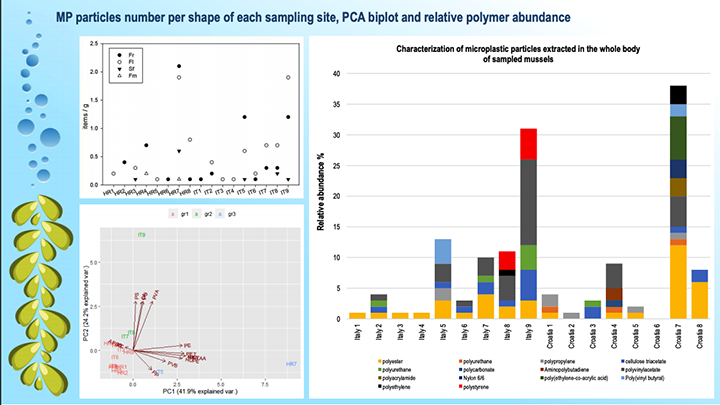
This study examined the overall bisphenol A (BPA) and microplastics (MPs) contamination status in mussels (Mytilus galloprovincialis) collected from aquaculture farms and one natural bed (Croatia) from all Italian and Croatian regions of the Adriatic Sea. Quantitative and qualitative assessments of MPs with a minimum size of 1 µm in the mussels were performed by stereomicroscope observation and Raman Microspectroscopy (RMS). In addition, an analytical quantification of polyethylene terephthalate (PET), polycarbonate (PC), para phthalic acid (PTA) and BPA has been conducted in mussel soft tissue by LC MS/MS method. The average number of MPs in Adriatic mussel is 1 item/g. Polyester and High Density Polyethylene were detected in 10 sampling sites, out of 17.. Free PTA, PC and PET were revealed in all samples, free BPA in 76,5%. The median of bisphenols detected in Italian mussel resulted with considerably higher EDI values (3-fold higher) compared to Croatian results and the THQ values above 1. The THQ values of BPA based on the percentiles, representing a higher scenario of exposure, were above one suggesting that there is risk of exposure higher than the safety limits recommended by the EFSA. The obtained results also revealed a potential risk of exposure to microplastics and associated contaminants in mussels as a food source. PCA analysis showed the existence of the differences in the polymer abundance inside the mussel’s tissue along the Adriatic coast despite the growth of mussels in the clear seawater and at distance from urban settlements. Probably, factors such as marine currents and sea depth affect the microplastics content in sessile organisms like mussels. Identification data should be combined with quantification data in order to estimate the mass of MP present in bivalves what is of great value for both environmental and human health risk assessment
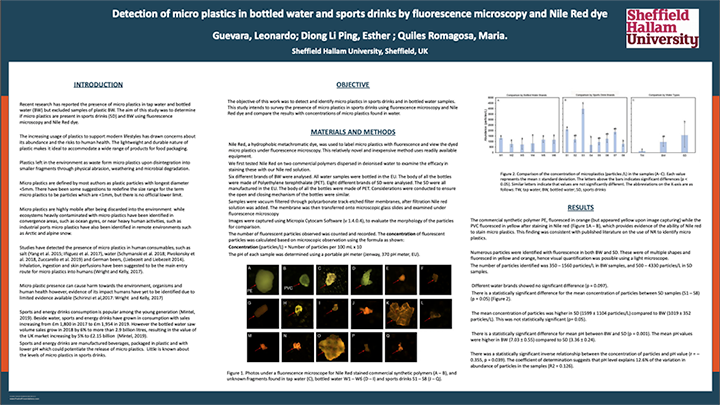
Detection of micro plastics in bottled water and sports drinks by fluorescence microscopy and Nile Red dye Guevara L. V., Diong L. P. E., Quiles Romagosa M. The aim of this study was to determine if micro plastics are present in sports drinks (SD) and bottled water using fluorescence microscopy and Nile Red dye. This project surveyed the presence of micro plastics in sports drinks using fluorescence microscopy and Nile Red dye and compare the results with concentrations of micro plastics found in bottled water (BW). Micro plastics are plastic particles with their largest diameter being <5mm. We first tested Nile Red on two commercial polymers dispersed in deionised water were used to examine the efficacy in staining these with our Nile red solution. Six different brands of BW were analysed. All water samples were bottled in the EU. The body of all the bottles were made of Polyethylene terephthalate (PET). Eight different brands of SD were analysed. The SD were all manufactured in the EU. The body of all the bottles were made of PET. Considerations were conducted to ensure the open and closing mechanism of the bottles were similar. Numerous particles were identified with fluorescence in both BW and SD. These were of multiple shapes and fluoresced in yellow and orange, hence visual quantification was possible using a light microscope. The number of particles identified was 350 – 1560 particles/L in BW samples, and 500 – 4330 particles/L in SD samples. All samples were found to contain microplastics. To date, this study is the first to suggest the presence of microplastics in SD.

A study of the consumers' perception of the threats posed by micro- and nanoplastics on the environment, food safety and supply chain.
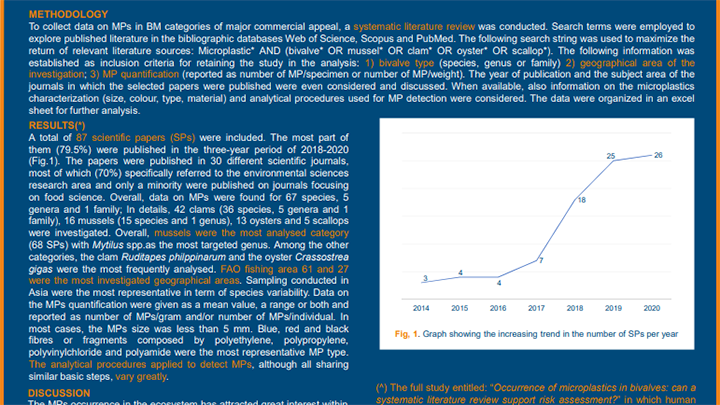
The poster provides some of the results obtained in a systematic revision of the literature entitled: “Occurrence of microplastics in bivalves: can a systematic literature review support risk assessment?” The paper is no under revision for the Journal Comprehensive Reviews in Food Science and Food Safety.

The widespread distribution of microplastics in the marine environment has subsequently affected the aquatic biota including seafood for human consumption. An increasing number of reports document the ingestion of microplastics by fish species and their occurrence in the gastrointestinal tract (Efsa, 2016). Although demersal fish are usually eviscerated before consumption, both fresh and dried small fishes are often consumed as a whole (Renzi et al., 2019). This is the case of Engraulis Encrasicolus, a commercially important small pelagic fish species, which has been proposed as a small-scale indicator both of microplastic contamination in open waters and human exposure (Compa et al., 2018). E. encrasicolus (n.20 samples from the Tyrrhenian Sea) were collected. The gastrointestinal tract was removed and analyzed applying the microplastic extraction method, according to Avio et al. (2015) and Foekema et al. (2013). Then microplastic morphological and physical classification and quantification analysis were carried out. As preliminary data, the application of the extraction method resulted in the efficient separation of microplastic from the organic tissues. Results showed the occurrence of fibers as plastic particles in the digestive tract of some fish samples. Seafood represents a considerable food vector for microplastic human exposure. Under the perspective of the human food chain, the microplastic trophic transfer and their bioaccumulation and biomagnification represent a serious issue to food safety (Efsa, 2016). Microplastics impact a high proportion of the wild E. encrasicolus caught in the Mediterranean Sea and their occurrence may be found also in other tissues than stomach contents. E. Encrasicolus as selective feeders species may ingest microplastics as prey (Compa et al., 2018). Considering that anchovies composing the main diet for pelagic predators in the Mediterranean Sea, and their relevance for human consumption, further studies targeting levels of litter and microplastics in natural stocks are essential (Renzi et al., 2019). Traceability of the fate of microplastic in contaminated seafood is essential to assess their bioaccumulation and biomagnification in the marine habitat and the potential trophic transfer from marine to the human food chain. References Avio, C. G., Gorbi, S., & Regoli, F. (2015). Experimental development of a new protocol for extraction and characterization of microplastics in fish tissues: first observations in commercial species from Adriatic Sea. Marine environmental research, 111, 18-26. Compa, M., Ventero, A., Iglesias, M., & Deudero, S. (2018). Ingestion of microplastics and natural fibres in Sardina pilchardus (Walbaum, 1792) and Engraulis encrasicolus (Linnaeus, 1758) along the Spanish Mediterranean coast. Marine pollution bulletin, 128, 89-96. EFSA Panel on Contaminants in the Food Chain (CONTAM). (2016). Presence of microplastics and nanoplastics in food, with particular focus on seafood. Efsa Journal, 14(6), e04501. Foekema, E. M., De Gruijter, C., Mergia, M. T., van Franeker, J. A., Murk, A. J., & Koelmans, A. A. (2013). Plastic in north sea fish. Environmental science & technology, 47(15), 8818-8824. Renzi, M., Specchiulli, A., Blašković, A., Manzo, C., Mancinelli, G., & Cilenti, L. (2019). Marine litter in stomach content of small pelagic fishes from the Adriatic Sea: sardines (Sardina pilchardus) and anchovies (Engraulis encrasicolus). Environmental Science and Pollution Research, 26(3), 2771-2781.
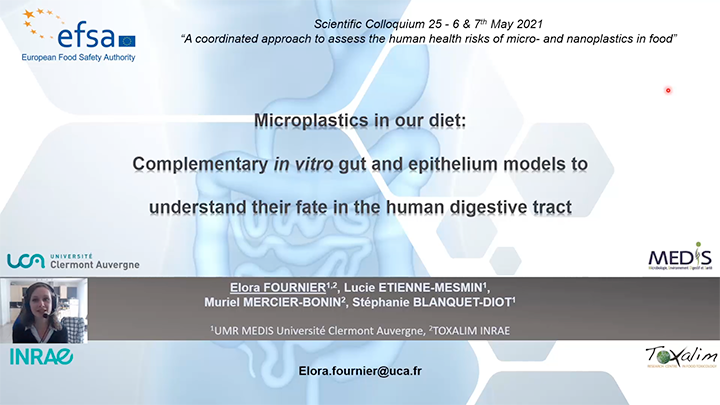
The aim of this work is to evaluate for the first time the fate of microplastics in the human digestive tract (under different ages and/or pathological conditions) by using complementary in vitro models of the gut lumen and intestinal epithelium : (i) the TNO Gastrointestinal model (TIM) which is currently the most complete simulator of the upper human GIT and reproduces the main physicochemical parameters of the stomach and small intestine (pH, temperature, transit time, digestive secretions and passive absorption), (ii) the Artificial Colon (ARCOL) which integrates the main physicochemical but also microbial (luminal and mucus-associated microbiota) parameters of the human colon and (iii) co-culture of Caco-2 and HT29-MTX (mucus-secreting) cells as a model of human intestinal epithelial cells.
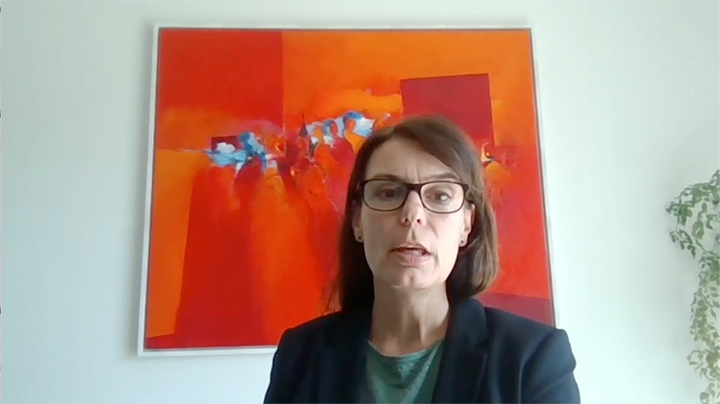
The risk profile on microplastics in the New Zealand diet (Pantos et al., 2019) identified that the characteristics and levels of chemical contaminants associated with microplastics in New Zealand are unknown. The levels of microplastics and its associated chemical contaminants will be determined in a range of food categories, including indigenous food. The key to establishing whether ingested microplastics present a toxicity concern through food is to determine their properties once consumed and whether there is appreciable systemic uptake and metabolism of plastics. In vitro bioavailability studies will assess the absorption rates of microplastics (labelled, virgin and aged-plastics, and pristine particles) and their contaminants through the human gut.
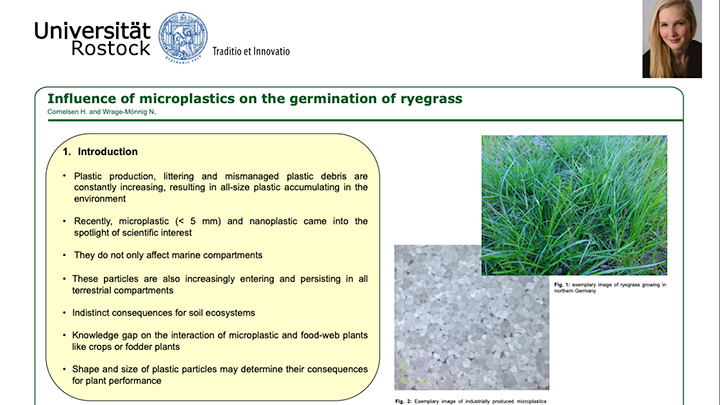
We analysed the impact of manufactured microplastics on the germination and juvenile growth of a commonly used ryegrass species.
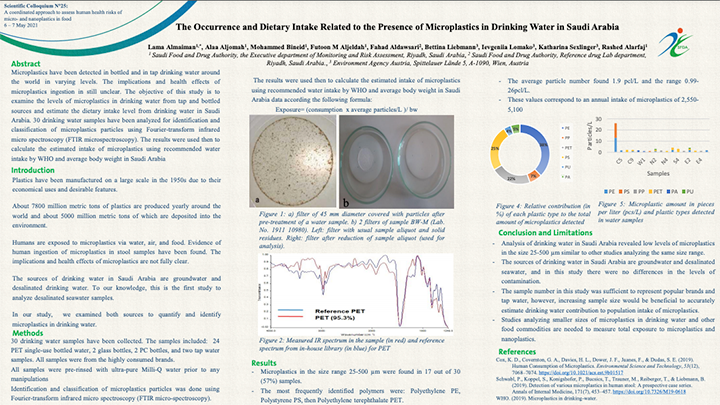
Background- microplastics have been detected in bottled and in tap drinking water around the world in varying levels. The implications and health effects of microplastics ingestion in still unclear. The objective of this study is to examine the levels of microplastics in drinking water from tap and bottled sources and estimate the dietary intake level from drinking water in Saudi Arabia. Method- 30 drinking water samples have been analyzed for identification and classification of microplastics particles using Fourier-transform infrared micro spectroscopy (FTIR microspectroscopy). The results were used then to calculate the estimated intake of microplastics using recommended water intake by WHO and average body weight in Saudi Arabia Results- microplastics were detected in 57% of samples. The average partilc/L number was 1.9 and 4.9 (LB, and Ubrespectively). The most identified polymers were PE, PET, and PS. The estimated intake was 1.7 particles/Kg bw/day for Saudi Adults. Conclusion- based on the available data from our study, bottled and tap drinking water in Saudi arabia have low levels of microplastics size 25-500 µm. The intake of microplastics from different sources of drinking water in Saudi Arabia is low compared to other countries
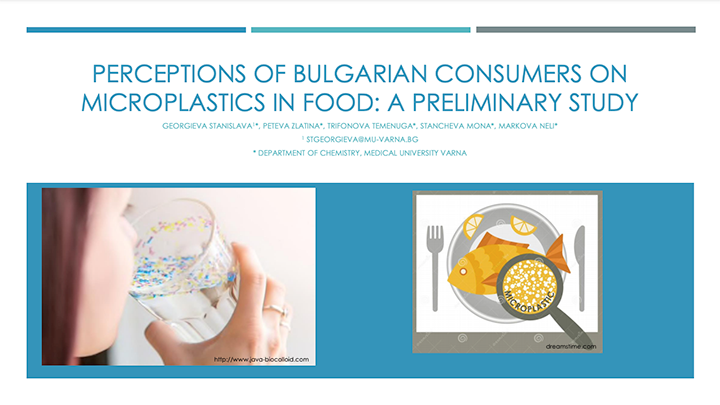
The intensive use of plastics in recent decades has led to the widespread distribution of plastic particles that remain in the environment indefinitely. Due to their small size (<5 mm), microplastics are considered bioavailable to organisms in aquatic ecosystems. Ingestion of microplastics by marine organisms can lead to the introduction of toxic substances at the base of the food chain and the potential for bioaccumulation. (Cole, et al., 2011). Plastic pollution is usually more visible and therefore different in this respect from other classical risks, such as those caused by chemicals.(Syberg, et al., 2018) The societal interest on the need to solve the problem of plastic pollution is driven by a combination of factors – e.g. reduction of plastic pollution visible in waters and coastal zones; concern about negative physiological and behavioural impacts on animals and other biota; and conflict with the moral convictions of individuals. (European Union, 2019) Changing individuals' perceptions and concerns about the risk of microplastics would lead to changes in consumer behavior. This implies the possibility of more effective control of microplastic pollution. Study of the general public’s knowledge and risk perception of microplastics are very limited (EC, 2019). The aim of this study is to conduct a preliminary evaluation of the perceptions and attitudes of consumers in Bulgaria towards microplastics as a problem in general and microplastics in food. A survey was conducted in six town including the capital city of Bulgaria in the period September 2019 - January 2020 by means of questionnaires. A preliminary validation of the questionnaire was done among 15 respondents and some questions were corrected. In the present survey, respondents were contacted personally and were asked to complete a self-administered anonymous questionnaire. The total sample consists of 191 persons. Part I of questionnaire (4 questions) asks for socio-demographic characteristics of each respondent. Part II (10 questions) collects information about the perception of the respondents on microplastics and their distribution in food. In this part, two types of questions were provided. Using a five point interval scale ranging from “no knowledge” to “expert” or “not concerned /interested” to “very concerned/interested”, the respondent was asked to evaluate his/her knowledge about microplastics, his/her concern on microplastics as a problem, if food products contain microplastics and if microplastics present in food are believed to be a health issue. The other six questions are multi select multiple-choice type. Hereby, is collected data about the main sources of information regarding microplastics, the distribution and presence of microplastics in food products, etc. Approximate time for answering questions- 10-15 minutes. Data was analyzed using MS Excel 2013. In total 194 respondents were contacted but because of missing answers in 3 questionnaires, they were removed. Тhe total sample analyzed consists of 191 persons whereas 30 % are men and 70% are women. Data analysis of other personal information shows that 42% of respondents are on age 18-30, 35 % - 30-45, 19%- 45-60 and 4% are over 60 years of age. Most of the respondents have a university degree (54%) and of 44%, highest level of education is secondary. Average value of self-evaluation of respondents of their knowledge of microplastics is 2.4. Highest mean level of this indicator is established by respondents in the age group 30-45 – 2.6. Average value of answers on respondents concern on microplastics is calculated 3.6. Mean results about the interest of respondents if food contain microplastics and if microplastics present in food could cause a health problem are resp. 3.5 and 4.1. Most interested in the topic are respondents with high school degree. Respondents in the age group 30-45 mostly agree that microplastics in food are a health issue. No significant differences are established between the different respondent groups. Internet is pointed as the main source of information about microplastics for all respondent groups. Most respondents would like to receive more information about microplastics via social media (27 %), television/radio (21%) and scientific publications (19 %). In total 194 respondents were contacted but because of missing answers in 3 questionnaires, they were removed. Тhe total sample analyzed consists of 191 persons whereas 30 % are men and 70% are women. Data analysis of other personal information shows that 42% of respondents are on age 18-30, 35 % - 30-45, 19%- 45-60 and 4% are over 60 years of age. Most of the respondents have a university degree (54%) and of 44%, highest level of education is secondary. Average value of self-evaluation of respondents of their knowledge of microplastics is 2.4. Highest mean level of this indicator is established by respondents in the age group 30-45 – 2.6. Average value of answers on respondents concern on microplastics is calculated 3.6. Mean results about the interest of respondents if food contain microplastics and if microplastics present in food could cause a health problem are resp. 3.5 and 4.1. Most interested in the topic are respondents with high school degree. Respondents in the age group 30-45 mostly agree that microplastics in food are a health issue. No significant differences are established between the different respondent groups. Internet is pointed as the main source of information about microplastics for all respondent groups. Most respondents would like to receive more information about microplastics via social media (27 %), television/radio (21%) and scientific publications (19 %). Among 191 respondents answers analyzed, the number of participants in age groups 18-30 and 30-45 as well with high school and university diploma is close. Therefore, their answers are discussed further. In general, respondents evaluate their level of knowledge of microplastics as lower than average (2.4). Despite their level of concern and interest if food consumed contains microplastics are above but closer to average (resp. 3.6 and 3.5). Furthermore, most respondents agree that ingested microplastics could pose a health risk. Comparison of respondents’ opinion on distribution of microplastics (Fig.1) shows that lakes, ground, everyday products, food and drinks are thought to contain microplastics. Young people (18-30 years) point lakes, seas and oceans, whereas respondents with age 30-45 think that mostly everyday products contain microplastics. Respondents with university degree think also that ground, food and drinks are main sources of microplastics. Comparison of respondents’ opinion on which food products could contain microplastics (Fig.2), interviewers mostly often indicate drinking water, beverages, fish, and other seafood. Hereby, respondents with higher education more often point more than four possible food products that might contain microplastics. Despite of the small sample size of the present study and its exclusively exploratory nature results in this paper indicate that Bulgarian consumers strongly believe that drinking water contains microplastics and microplastics in food could be a serious health threat.
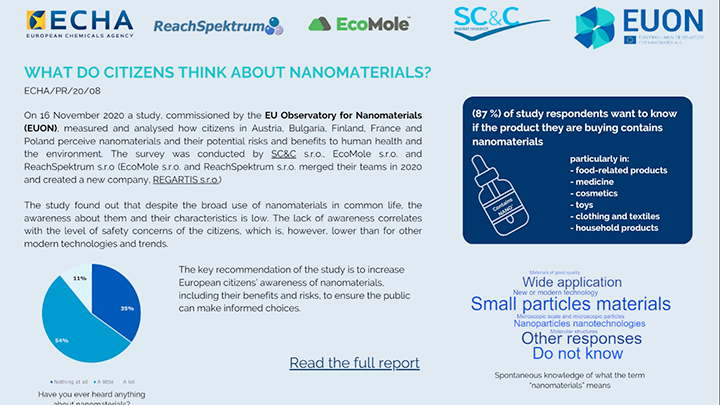
A study about the public's perception of nanomaterials and their safety for human health and the environment was conducted and published in November 2020. This poster concludes its findings.

the diet of a dairy cow can be a source of exposure to different environmental pollutants (e.g. dioxins) and it can be expected that the same route of exposure can occur for nano- and microplastics (NMP). On average, per day, the diet of a Dutch dairy cow is composed of approximately 90% of roughage (including fresh grass, maize and silage) and 10% of concentrates (such as maize, soya, citrus, palm and rapeseed meal, beetroots, wheat and by-products of other industries). During grazing, cows can ingest soil, and although soil cannot be considered a traditional feed component, dairy cows may be exposed to NMP via the ingestion of soil. It must be taken into account that all the above-mentioned feed components can be a route of exposure of dairy cows to NMP. In the Netherlands, drinking water production (tap water) mainly uses ground and surface water (KWR, 2019). But a cow may also drink water directly from surface water (e.g. rivers, lakes or canals). Therefore, both tap- and surface water should be considered as possible sources of exposure of dairy cows to NMP. With some feed contaminants there is a carryover from the feed to the milk produced by dairy cows. It is important to assess whether the same may occur with NMP. Therefore, the objective of this literature review is to assess if dairy cows are exposed to NMP via the feed and water, to which levels and if ingested NMP can be excreted via milk. For an extensive literature review, mainly Google scholar was used to retrieve, preferably, up-to-date articles focusing on the presence of NMP in feed and water of dairy cows. Search was done until September 2019. The key-strings were chosen to include the range in the materials to screen, such as nano- and microplastics and the most common polymers present in plastic particles. Key-strings also included the variability in the feed composition, including the different types of roughage most commonly used in the Netherlands and the most common feed products present in concentrates. Lastly, key strings included the different sources of drinking water available to a dairy cow, from tap- to surface-water. The key-strings were used in a stepwise approach and the retrieved hits were first screened for importance based on their title and abstract. Subsequently, relevant articles were used for data extraction. A regular search on google was done to identify reports prepared by national and international organizations. There is limited information of microplastics in soil, but values seem to vary between 0,34 ± 0,36 particles / kg dry weight soil and 5 particles /kg soil for farmland soil and flooded plains, respectively. To our knowledge, there are no studies reporting the presence of NMP in roughage or nanoplastics in soil. Also, there is no available data regarding the presence of NMP in concentrates but they may contain up to 0,7 % (w/w) of packaging material (also containing plastic). Concentration of microplastics in drinking water seems to be higher in tap water from surface water (5,45 particles / L) than in groundwater (0,0007 particles / L; WHO, 2019). In the Netherlands, in general, outside urban areas, the highest concentrations of microplastics are found near (effluent) of wastewater treatment plants (WWTP; 81 particles / L). To our knowledge there are no studies reporting the presence of nanoplastics in freshwater systems. During grazing, a cow can eat up to 1 kg of soil per day. Depending on the location of the farm, a cow may ingest between 0,34 and 5 particles per day. A cow drinks, on average, 100 L of water per day. Depending on the source of the water, a cow might ingest between 0,07 and 8100 particles per day. Based on the limited information, water seems to be the most important source of exposure of dairy cows to microplastics and the location of the farm may influence the exposure levels of dairy cows to microplastics. Based on the limited available information, there are no indications that microplastics in drinking water pose a health risk for humans (WHO, 2019). To our knowledge, at the moment, there are no studies that look at the effect of microplastics on the health of dairy cows, or whether ingested NMP reach the milk. It is generally assumed that microplastics > 150 microM are excreted through faeces, but the fate of smaller particles in unsure. It is known that nanoparticles are capable of crossing the gut barrier ending in tissues and milk, but we cannot extrapolate these results to nanoplastics since the properties of nanoparticles are determined by many of the particles characteristics, such as charge, shape, material, etc. and not only by size. Therefore more research is needed to assess the toxicological properties of NMP, their distribution, kinetics and health effects of NMP, including their capability to cross the gut barrier and reach the milk of dairy cows.
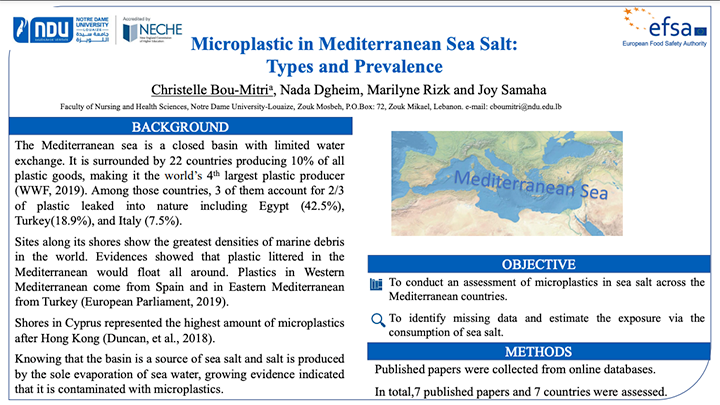
The Mediterranean sea is a closed basin with limited water exchange. It is surrounded by 22 countries producing 10% of all plastic goods, making it the world’s 4th largest plastic producer. Plastic litter is loading the sea with microplastics contaminating by that all the marine products including sea salt. This study compiled all the studies conducted on sea salt extracted from the Mediterranean to evaluate the prevalence of contamination as well as the types, sizes and shapes of microplastic. This study will allow to assess exposure to microplastic through the consumption of sea salt per region or country, tracing contamination source, identifying the level of contamination per country and identifying gap for future research.

The risks posed to human health by NMPs associated microorganisms are hard to quantify at this time. There is clear scientific evidence that NMPs have found their way to every part of the biosphere from urban centres to the poles, remote oceans and the deep sea. However, research has particularly focused on the marine environment, leaving gaps of knowledge on environments which are actually closer to most humans such as fresh waters and soils. The research team that we have assembled for this project (Cefas, FERA, and University of Exeter) represents a unique consortium of UK governmental and regulatory laboratories, and academic partners to achieve this desk-based critical review.

The topic of micro- and nanoplastics gained much public attention, since it has been discovered recently that microplastic particles reach the human gastrointestinal tract via food products. Quantification of oral uptake of such particles, however, is still very challenging. Very little is known about the bioavailability and the fate of microplastic particles in the human body or potential adverse effects. There are major knowledge gaps regarding the correlations between bioavailability, particle size, material type and potential mechanisms of action. Therefore, a profound risk assessment is currently not possible. Even less is known about nanoplastics, due to the lack of characterized materials and analytical methods.
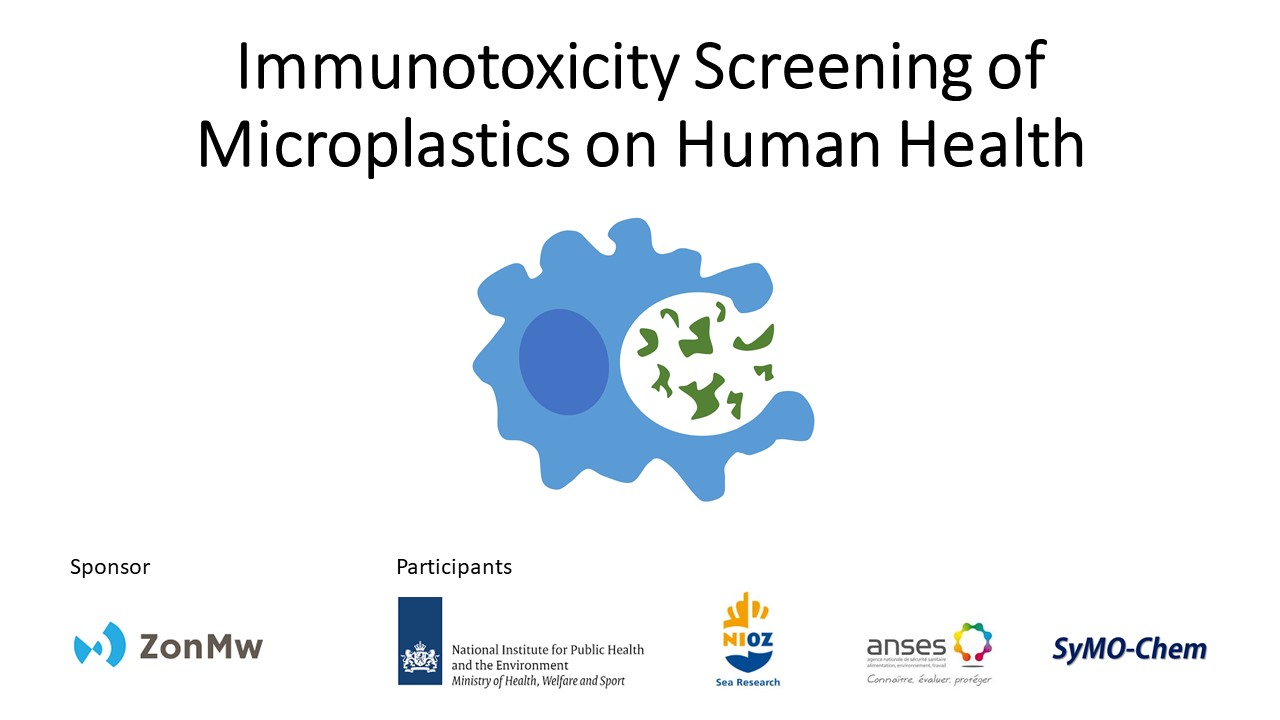
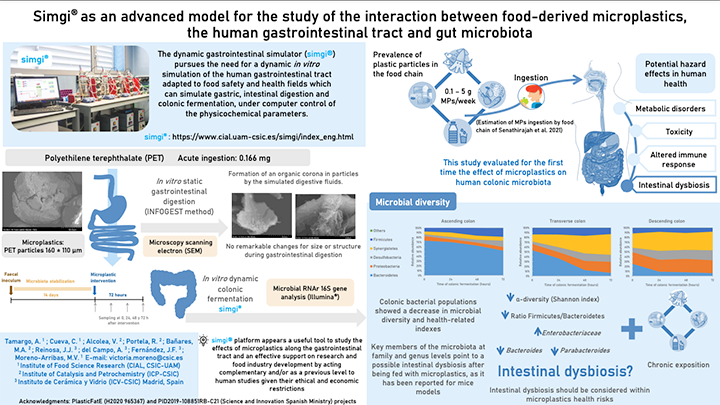
Introduction The prevalence of plastic particles in the food chain is already evident. Therefore, the scientific community is concerned about the health risks of food-use microplastics; although the risk assessment of microplastics is not possible, it is a current global challenge. The dynamic gastrointestinal simulator (simgi®) pursues the need for a dynamic in vitro simulation of the human gastrointestinal tract adapted to food safety and health fields (www.cial.uam-csic.es/simgi/). The simgi® system can simulate separately or in continuous gastric, intestinal digestion, and colonic fermentation, under computer control of the physicochemical parameters. Furthermore, the simgi® platform has confirmed its models suitability since its first studies showed the consistency between the simulated digestion of food products and the metabolic evolution observed with the intake of the same products in human intervention studies. Its modular configuration has allowed the study of miscellaneous products as dietary fibres, probiotics, proteins and polyphenol-rich food matrices to evaluate their gastrointestinal digestion and impact on gut microbiota. Moreover, simgi® dynamic operation allows the simulation of acute and chronic intakes, which are used to study short- and medium-term effects of digested products. Therefore, the simgi® system is an exclusive tool to monitor avant-garde products of interest, such as nanoparticles [1] and microplastics, which food safety is yet to determine. This study aims to evaluate the impact of the main stages of the human gastrointestinal tract on different relevant food-use plastic materials, also to ascertain the effect of digested microplastics on gut microbiota composition and functionality. Methodology Two microplastic size ranges have been used as prototypes: pellets between 2.8 and 3.6 mm and milled plastics between 50 and 300 µm. Polyethylene terephthalate (PET) was considered as a model for non-biodegradable microplastic, whereas polylactic acid (PLA) was used as biodegradable. Initial steps focused on performing the studies needed to configure the simgi® system as a useful tool for monitoring microplastics in the human gastrointestinal tract. Thus PET pellets, milled PET, PLA pellets, and milled PLA were digested in vitro according to the standardised static gastrointestinal digestion food protocol [2] to establish digestion influence on the microplastics and simgi® digestion parameters. Microplastics size, shape, and stability (using FESEM, FT-IR Spectroscopy, and Raman spectra) were evaluated after gastric and small intestinal digestion for the microplastic models. The physiological conditions of the ascending, transverse, and descending colon were reproduced sequentially on the simgi® colonic bioreactors, which included a simulated human colonic microbial community, to study the interaction between the gut microbiota and microplastics. Each colonic bioreactor was fed with a dose of 0.166 mg digested milled PET particles. The milled PET dose, was selected considering previous estimations of human microplastic intake from food and beverages [3]. Changes in microbiota composition (microbial plate counting and sequencing 16S rRNA), microbial metabolic activity (ammonium and SCFA production), and microplastics shape and stability (using FESEM, FT-IR Spectroscopy, and Raman spectra) were evaluated in the ascending, transverse, and descending colon after feeding the system with microplastics. Results In this study, a novel lab practical guidance, designed for operation with microplastics, on simgi® was proposed. At the gastric and intestinal levels, there were no remarkable changes for the size or structure of the studied particles. However, all microplastics showed organic material deposits on their surface after in vitro gastrointestinal digestions (Figure 1 as an example of milled PET after gastric and intestinal digestion). At the colonic level, milled PET particles induced several changes in colonic microbiota composition/diversity. Using plate counting, total aerobic and total anaerobic microorganisms considerably decreased (Δ log (CFU/mL) ≥- 3) during 72 hours of colonic fermentation in all colonic compartments. Furthermore, a notable reduction of Bifidobacterium spp. and Clostridium spp. groups were observed after the first 48 hours of fermentation. Likewise, 16S rRNA gene sequence analysis showed reductions in alpha-diversity indexes, especially for the transverse and descending colon in the first 24 hours of fermentation. Phylogenetic analysis at the phylum level exhibited differences in the relative abundances of important taxa after being fed microplastic, although they were compartment dependent. Bacteroidetes was reduced for all colonic compartments, whereas Firmicutes abundance increased in the ascending colon, Proteobacteria and Synergistetes in the transverse colon, and Desulfobacteria in the descending colon. Regarding the most important members at the genus level, results revealed differences in the relative levels of Bacteroides and Parabacteroides, with an important decrease in all colonic compartments being detected, and the most evident effect in transverse and descending colon, reaching values below 5%. Discussion In vitro static gastrointestinal digestion simulations [2] allowed the study of the interaction between microplastics and the human gastrointestinal tract. Furthermore, results presented at the gastrointestinal level, agree with those reported for microplastic gastrointestinal digestions [4], suggesting the formation of an organic corona in particles by the simulated digestive fluids. However, neither the colonic stage nor colonic microbiota are included in previous digestion models, which also cannot simulate the effects of a chronic intake, which is the actual situation of microplastics intake, considering the latest data estimated for the inadvertent ingestion of microplastics [3]. Therefore, it is noteworthy to be able to simulate the colonic stages, as it was simulated on the dynamic simgi® system. In fact, this study has evaluated for the first time, to the best of our knowledge, the microplastic effect on the human colonic microbiota. Colonic bacterial populations showed a decrease in alpha-diversity and Firmicutes/Bacteroidetes ratio, which are considered as health-related indexes. Furthermore, the analysis of the key members of the microbiota at family and genus levels corroborated the results which point to a possible intestinal dysbiosis after being fed microplastics, as was reported for mice models [5]. Although this project is still in its infancy, the simgi® platform appears a useful tool to study the effects of microplastics along the gastrointestinal tract, and an effective support on research and food industry development by acting complementary and/or as a previous level to human studies, given their ethical and economic restrictions. [1] Cueva, C., Gil-Sánchez, I., Tamargo, A., Miralles, B., Crespo, J., Bartolomé, B., & Moreno-Arribas, M. V. V. (2019). Gastrointestinal digestion of food-use silver nanoparticles in the dynamic SIMulator of the GastroIntestinal tract (simgi®). Impact on human gut microbiota. Food and Chemical Toxicology, 132(July), 110657. https://doi.org/10.1016/j.fct.2019.110657 [2] Brodkorb, A., Egger, L., Alminger, M., Alvito, P., Assunção, R., Ballance, S., Bohn, T., Bourlieu-Lacanal, C., Boutrou, R., Carrière, F., Clemente, A., Corredig, M., Dupont, D., Dufour, C., Edwards, C., Golding, M., Karakaya, S., Kirkhus, B., Le Feunteun, S., … Recio, I. (2019). INFOGEST static in vitro simulation of gastrointestinal food digestion. Nature Protocols, 14(4), 991–1014. https://doi.org/10.1038/s41596-018-0119-1 [3] Senathirajah, K., Attwood, S., Bhagwat, G., Carbery, M., Wilson, S., & Palanisami, T. (2021). Estimation of the mass of microplastics ingested – A pivotal first step towards human health risk assessment. Journal of Hazardous Materials, 404(PB), 124004. https://doi.org/10.1016/j.jhazmat.2020.124004 [4] Stock, V., Fahrenson, C., Thuenemann, A., Dönmez, M. H., Voss, L., Böhmert, L., Braeuning, A., Lampen, A., & Sieg, H. (2020). Impact of artificial digestion on the sizes and shapes of microplastic particles. Food and Chemical Toxicology, 135(October 2019). https://doi.org/10.1016/j.fct.2019.111010 [5] Luo, T., Wang, C., Pan, Z., Jin, C., Fu, Z., & Jin, Y. (2019). Maternal Polystyrene Microplastic Exposure during Gestation and Lactation Altered Metabolic Homeostasis in the Dams and Their F1 and F2 Offspring. Environmental Science and Technology, 53(18), 10978–10992. https://doi.org/10.1021/acs.est.9b03191

Overview of the Research projects PlasticsEurope is working on to support the development of a microplastics Human Health risk assessment framework
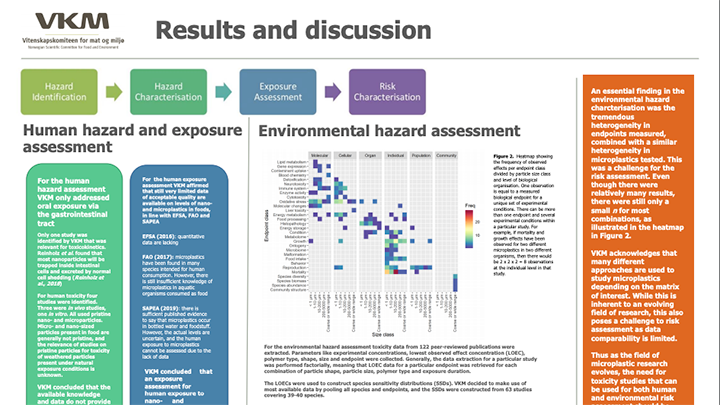
This is a poster presentation of an opinion published by VKM in 2019. The presentation is 4 pages, contains mainly text, one picture and two figures.
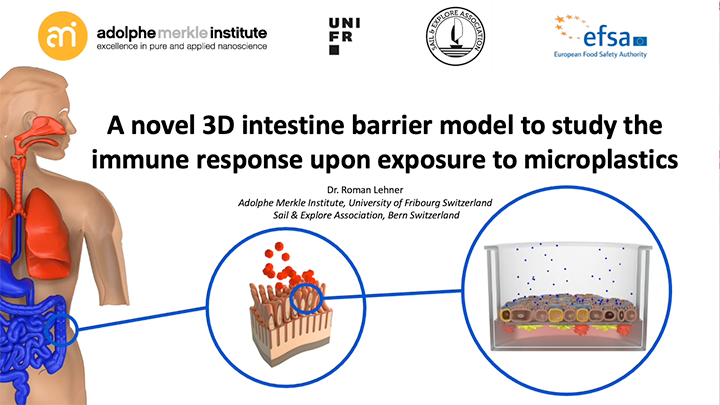
Plastics have shaped our society within the last centuries like no other materials. Their production has increased to more than 350 million metric tons worldwide in 2018 with around 40% of all plastics being incorporated into single use products such as plastic bags, food and drink containers or cups (1). The growing production of synthetic plastic products also led to a substantial increase of poorly managed plastic waste, which results in their widespread and increasing accumulation within the environment. The plausibility of human exposure to microplastics has increased within the last years (2). Microplastics have been found in different food types including seafood, salt, sugar and beverages (3,4). So far, human health effects of microplastics after ingestion are unknown. Herein we designed a novel, three-dimensional in vitro intestinal model consisting of the human intestinal epithelial cell lines Caco-2 and HT29-MTX as well as human blood monocyte-derived macrophages (MDMs) and dendritic cells (MDDCs) that is suitable to assess possible effects of ingested microplastics. We used environmentally relevant microplastics representing the main sources of secondary microplastics observed in the environment, e.g. particles of polypropylene (PP), of tire dust, polyamide (PA) and harder cross-linked and a softer thermoplastic version of polyurethanes (PU).

The AURORA project will develop an Actionable EUropean ROadmap for early-life health Risk Assessment of micro- and nanoplastics. It's one of 5 recently launched, H2020 funded research projects aimed at improving human health risk assessment of micro- and nanoplastics. AURORA focuses on early-life health impacts: reproductive health, placental functioning and fetal development are the focus. Food and food contact materials as exposure source will be assessed.
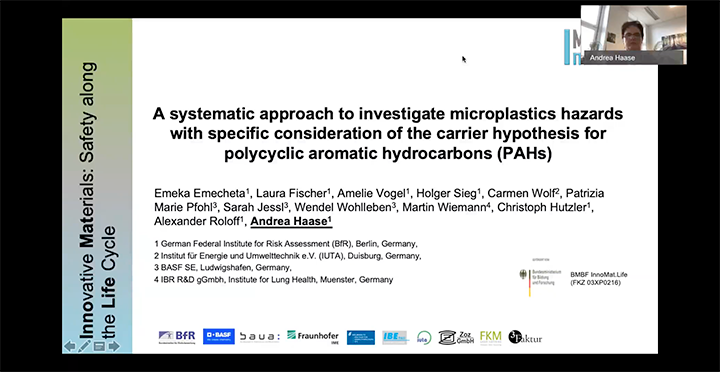
Investigating possible human health effects of micro- and nanoscaled plastic particles (MNPs) is challenging for several reasons. MNPs are complex mixtures of diverse geometries, shapes and sizes that can be based on different polymer types (e.g. polypropylene (PP), polyethylene (PE), polyamide (PA), polyurethane (PU)). Additionally they contain additives (e.g. antioxidants, vulcanizers, pigments) and several contaminants (e.g. remaining traces of catalysts, traces of monomers and oligomers). Moreover, they may act as carriers for environmental persistent organic pollutants (POPs) like polycyclic aromatic hydrocarbons (PAHs), polychlorinated biphenyls (PCB) or others. There is no consensus yet which properties are most important for hazard assessment, or if all solid, persistent MNPs should be assessed jointly. Thus, assessing possible hazards of MNPs is a complex endeavor. Within the German BMBF funded project InnoMat.Life (www.innomatlife.de) we investigate a selection of different MNPs, covering different polymers (e.g. PE, PA, PU) with broad size distributions. In a first step ad- and desorption of selected POPs are assessed. In parallel, we conduct in vitro based studies using different cell models (liver and lung cell models). These will guide in vivo studies. PE has been chosen as a benchmark material. In addition, several types of PA (PA-6, PA-12), PU (4 variants), PMMA (2 variants) and a rubber material obtained from recycled truck tires were included. For assessing the sorption of PAHs, benzo[a]pyrene (B[a]P) was selected as a lead substance along with dibenzo[a,l]pyrene (DB[a,l]P) and anthracene (Anth). Firstly, we developed a universally applicable third polymer-phase partitioning (TPP) method, which enabled to quantify the sorption of pollutants on various polymer particles without filtration. We analyzed the sorption of B[a]P for over 20 MNP variants, including a few aged ones. The sorption of Anth and DB[a,l]P was also studied for selected variants. The TPP method was validated using the commonly applied batch method. In parallel, we investigated the biocompatibility of the polymer particles in three selected cell models, human intestinal epithelial Caco-2, human liver epithelial HepG2 and rat alveolar macrophages NR8383. In addition, the carrier effects of the MNPs were investigated for B[a]P and two heavy metals in HepG2 and Caco-2 cells. Using the TPP method, we could show that the polymer particles strongly differed in their sorption behavior with surface area and hydrophobicity as the most influencing factors, which enabled a first ranking and categorization. All polymer particles were not cytotoxic. Only the particles derived from tire rubber were found to induce CYP1A1 expression in both cell lines even in the absence of pollutants. Overall, our work contributes to better understand the human health hazards of polymer particles. The broader aim of our project is to provide criteria for grouping of different polymer particles.

A scientific report based on solid scientific data has been published by AESAN Identifying the most relevant dietary sources of microplastics, knowing the occurrence of the different molecules and polymers and their relevance in terms of exposure will contribute to focus future research projects, regulatory initiatives and monitoring programs. It is the interest of AESAN to promote research on MP and NP in the food supply and contribute to fill the identified knowledge gaps. Toxicokinetic; biomarkers of exposure; toxicity in experimental animals/models like acute toxicity, repeat dose and chronic toxicity; mode of action of the different MP and the observations in humans (Acute and Chronic effects); health based guidance values (dose response models and selection of critical reference points) Assessing the Spanish population dietary exposure to MP should be a challenge for our Food Safety experts and networking among the research groups should be promoted through our national food agencies and EFSA.

In this work, we present the testing strategy that has been recently applied to the toxicity characterization of ingested nanomaterials in human intestinal cell models. We propose the use of similar predictive toxicology approach based on defining the key events at cellular and molecular levels, to identify and characterize the hazard of micro- and nanoplastics, thus contributing to their risk assessment.

Microplastics are widespread contaminants and therefore also present in food and beverage, leading to human exposure. Determination of microplastics in matrices starts with sample collection, with adequate contamination control measures. Sample preparation must be adapted to each sample type, possibly requiring more than one step depending on its composition. Nile Red staining can provide an easy tool for the quantification of stained microplastics but is dependent on previous efficient removal of biogenic organic matter during sample preparation. Spectroscopic methods may follow to provide chemical characterization, which can also benefit from Nile Red staining which provides an identification of suspected particles without interfering with spectra collection.
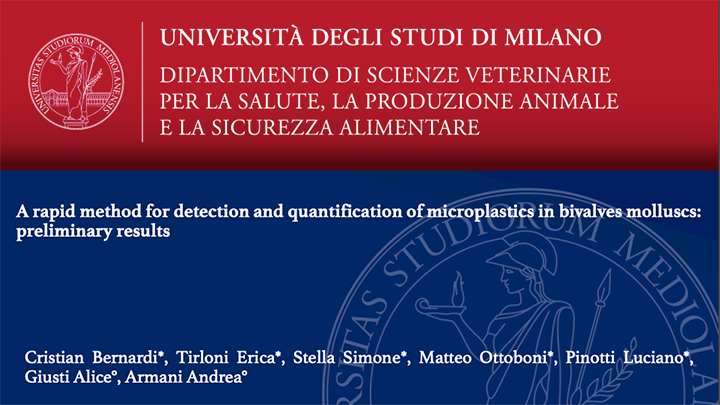
In this preliminary work, based on an ongoing project, a one-step method consisting in alkaline digestion and direct filtration without any flotation step was developed and then used for detecting MPs in three species of BM (Mytilus galloporovincialis, Chamelea gallina, Ruditapes philippinarum).The one-step protocol developed in this study allowed to completely digest the bivalve tissues in all the species analyzed. The maximum concentration of MP g-1 was found in the R. philippinarum with values of 2.12 MPs g-1. The lowest values were instead recorded in the M. galloprovincialis with a value of 0.8 MPs g-1, and in C. gallina with 0.30 MPs g-1. Overall, a high proportion of fibers was observed (95% of total microplastics), while fragments were the second most abundant morphotype (5%). Regarding the color of MPs in samples, blue and green fibers were the most abundant, followed by black and red. The most frequent length range of MPs was 200-800 µm (66% of observed MPs). In the control blanks, the number of MPs observed in each blank ranged between 1 and 14 MPs filter–1, with a mean of 5.33±4.59 MPs filter -1.
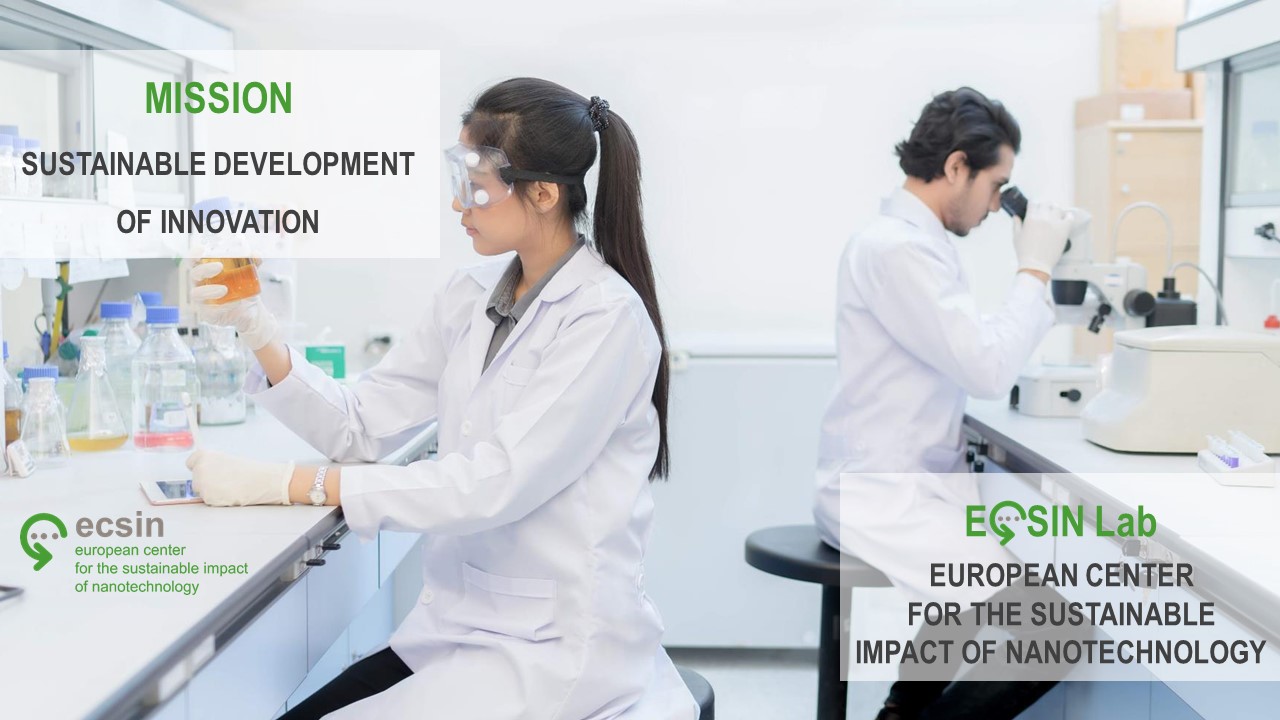
Microplastics identification represents a challenging topic since no officially recognized methods are still available. ECSIN LAB developed and validated specific methods for investigating microplastics in different matrices such as drinking water, beverages, mineral salts, fish and grocery products, detergents, cosmetics and environmental matrices. Validation process considered: - process verification and possible contamination through blank analysis; - recovery assessment of the number of added microplastics; - assessment of the integrity (size and shape) of added microplastics; - verification of chemical nature of added microplastics. Validated methods are a three-steps process: (i) sample preparation with the aim to completely degrade matrix; (ii) filtration to collect remaining particles; and (iii) µFTIR to analyze particles on filter by µATR and chemical imaging modes. The method for identifying microplastics in food, animal feeding stuffs and waters has been certified by ACCREDIA.
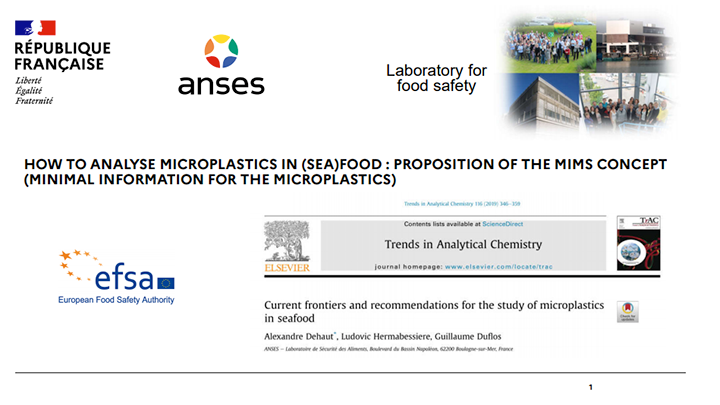
This presentation is devoted to the minimum information for publication of microplastics studies (MIMS) to avoid misunderstood and lack regarding contamination at the laboratory scale, sampling and isolation, and quantification and identification.

In the last decade, environmental problems caused by microplastics (MPs) has been at the centre of scientific interest. MPs have been detected globally in a wide range of environmental elements, but much less focus is given to microplastics in drinking water. Water processing plants, processing either surface water or underground water were investigated in Hungary. For sampling, filters with 15 µm mesh size were exposed to approximately 2000 litre of water. The exact quantity was measured with a water meter with 0.1 L precision. Samples were analysed by FTIR microscopy. No clear connection between technology and sampling location (raw, clear) could be drawn, but MPs (mostly PE and PTFE) have been indicated. The study serves as an indication, but more detailed monitoring programs are needed in the future.

We took different plastic samples from different suppliers and we analysed them with a FTIR spectrometer with a photoacoustic detector (no litterature about it). All collected spectra were then processed to detect differences, if present, among different type of polymers. It was possible to distinguish samples that could be well separated by cluster analysis. A number was assigned to each spectra and a library with database entries was created.
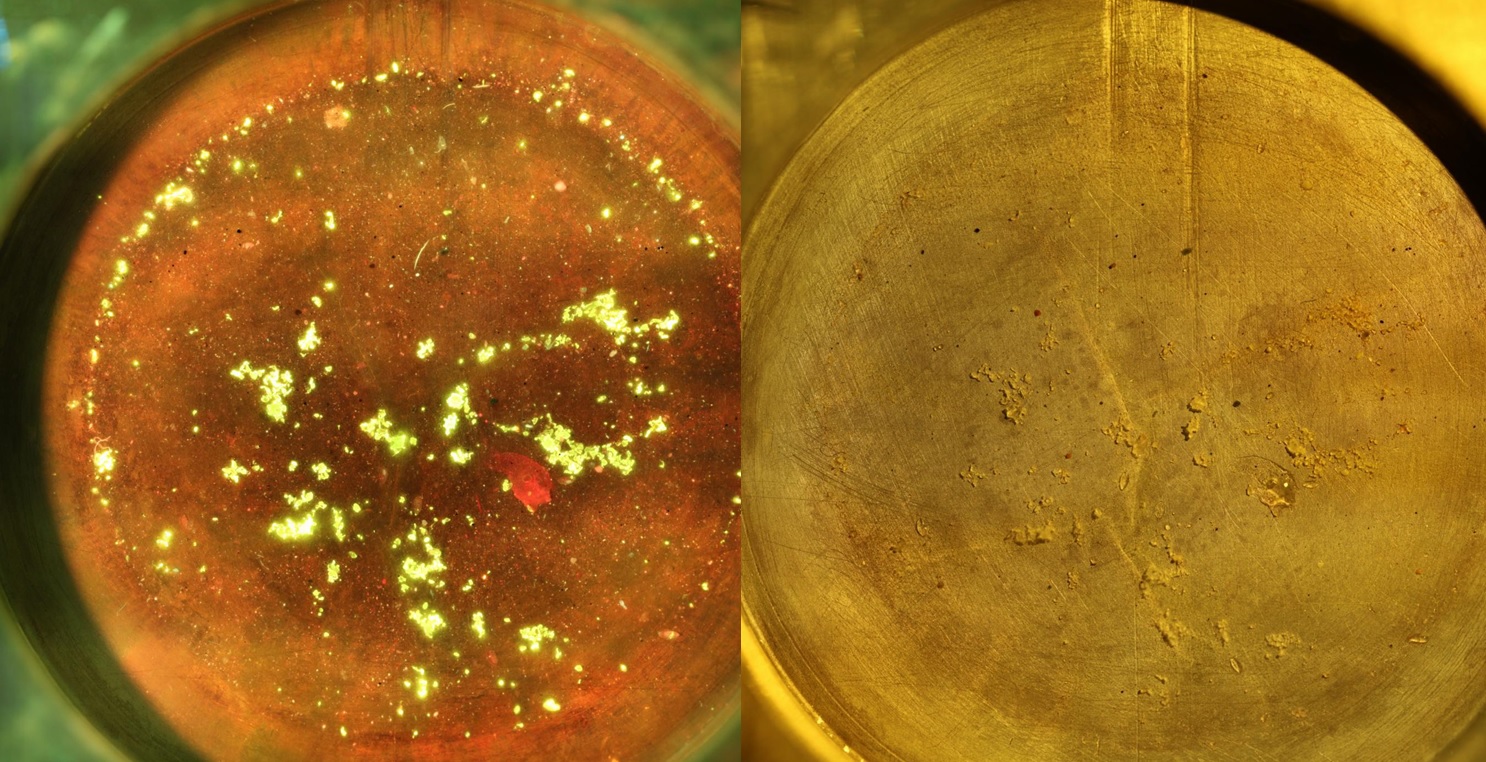

During the last years, several studies were published, investigating the abundance of microplastics in clean waters, such as ground, tap or bottled waters. However, methods show a huge diversity in experimental setups and often a lack of certain quality assurance aspects. To overcome this issue, harmonization of analytical methods is necessary. To take a step towards a methodological alignment, a group of twelve European laboratories experienced in microplastic analysis was founded. This group, representing public authorities (e.g., universities, research institutes and authorities for consumer protection) as well as industrial labs, discussed and developed a common working paper for the analysis of microplastics in clean water. Minimum requirements and best practice guidelines were established for all relevant steps, e.g., avoidance of sample contamination, sampling and sample preparation, spectroscopic analysis with Raman or infrared spectroscopy and method validation.

Many studies have focused on the presence of microplastics in the marine environment, including seafood such as mussels, crab and fish. Data on other food matrices is scarce and limited to a few food groups. This illustrates the need for an extensive analysis of the diverse food basket, as it remains unclear to what extent different food items contribute to the microplastic exposure of consumers. In the ‘Plastic in Food’ project (financed by the Federal Public Service of Health, Food Chain Safety and Environment), ILVO and Sciensano determined the occurrence of microplastics in >200 food items. The poster shows the method, the validation and the results of the food items. The chemical identifitcation using µFTIR of the 54 isolated microplastics is also described.

The necessity to improve comparability of quality control increases with an increasing number of microplastic studies. Recovery rate is an important feedback component that identifies accuracy, quality and efficiency of sample treatment and also final results. In this study we analysed recovery rates from quality control samples by adding standardized polystyrene beads, hence imitating different sample treatment protocols (marine sediment, marine surface water, freshwater sediment treatment protocols). Besides, we also tested sample extraction methods (vacuum filtration apparatus and stainless steel sieve) as possible physical impact throughout material treatment process. Our results showed that the overall recoverability (%) depends on the total number of processing steps (physical impact) rather than chemical impact. Therefore, for quality assurance, we recommend to use recovery rate thresholds depending on number of sample treatment steps involved and filtering method used.